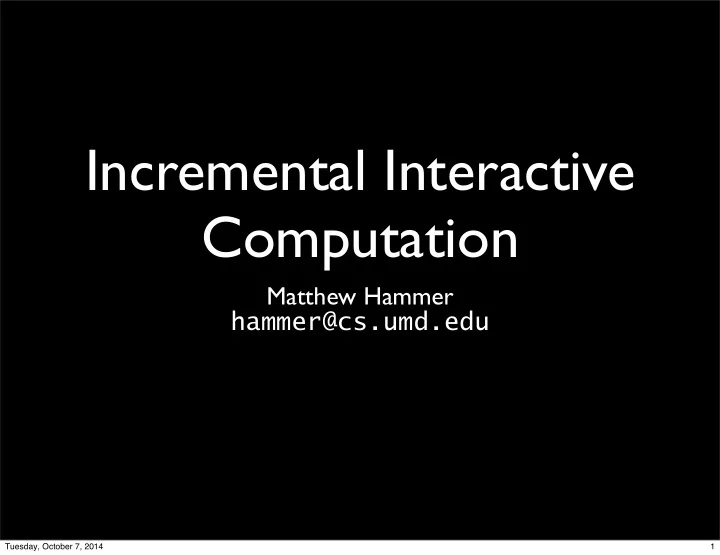

Incremental Interactive Computation Matthew Hammer hammer@cs.umd.edu Tuesday, October 7, 2014 1
Incremental Interactive Computation Matthew Hammer hammer@cs.umd.edu Tuesday, October 7, 2014 2
Batch Computation vs Interactive Computation Input Batch Model C Output No time, no dialogue Input Interactive Output C U Model Input Output Dialogue in time Tuesday, October 7, 2014 3
Interaction is a Dialogue Creates input Time Time Demands Output U C Mutates input Demands Output Interacting Reactive User Computation Tuesday, October 7, 2014 4
Elements of Interactive Dialogue • User and system interact across time • User mutates / changes input structure • User demands / observes output structure • The system maintains a correspondence between input and output structures • I/O correspondence is computational Tuesday, October 7, 2014 5
Incremental Interactive Computation Tuesday, October 7, 2014 6
Incremental Interactive Computation Claim: Interesting Input interactive Output C systems consist of U Input incremental computations Output Tuesday, October 7, 2014 7
Example: Spreadsheets Input Cell Formulae Structure Incremental Formula Computation evaluation Output Cell values Structure Tuesday, October 7, 2014 8
Example: Word processing Input Document Structure Content Incremental Spell-check Computation each word Output Highlight Structure misspellings Tuesday, October 7, 2014 9
Example: Programming Input Text file Structure Computation Parse tokens Output AST Structure Input AST Structure Computation Lexical scoping Output Def/use edges Structure Input AST + Def/use Structure Computation Type inference Output Type errors Structure Tuesday, October 7, 2014 10
Computing Incrementally 1. Input changes are gradual Full re-computation is often redundant 2. Output observation is limited Full re-computation is often overly eager Tuesday, October 7, 2014 11
Computing Incrementally 1. Input changes are gradual 2. Output observation is limited Example: Cells change slowly Spreadsheet Document and Example: dictionary both Word processing change slowly Example: Program changes Programming slowly Tuesday, October 7, 2014 12
Computing Incrementally 1. Input changes are gradual 2. Output observation is limited Example: One worksheet is Spreadsheet active, others hidden Example: Viewport shows one Word processing or two pages Viewport shows one Example: file, module or Programming function Tuesday, October 7, 2014 13
Adapton Programming Abstractions for Incremental Interaction Tuesday, October 7, 2014 14
Adapton Programming Abstractions • Mutable references: • Hold changing input structure • Lazy thunks: • Demand-driven computations • Output structure Tuesday, October 7, 2014 15
Mutable 1 2 3 4 references + min max Incremental Computation (thunks) + * min max Demand-driven Outputs Tuesday, October 7, 2014 16
Mutable 1 2 3 4 references + min max Incremental Computation (thunks) + * min max Demand-driven Outputs Tuesday, October 7, 2014 17
Mutable 1 2 3 4 references max + min 2 5 Incremental Computation (thunks) + * 7 max min 7 Demand-driven Outputs Tuesday, October 7, 2014 18
Mutable 1 2 3 4 references max + min 2 5 Incremental Computation (thunks) + * 7 max min 7 Demand-driven Outputs Switch Demand: Tuesday, October 7, 2014 19
Mutable 1 2 3 4 references max + min 2 5 3 Incremental Computation (thunks) + * 7 15 max min 7 3 Demand-driven Outputs Switch Demand: Tuesday, October 7, 2014 20
Mutable 1 2 3 4 references max + min 2 5 3 Incremental Computation (thunks) + * 7 15 max min 7 3 Demand-driven Outputs Sharing Tuesday, October 7, 2014 21
Input Change: Mutable 1 2 3 4 references max + min 2 5 3 Incremental Computation (thunks) + * 7 15 max min 7 3 Demand-driven Outputs Tuesday, October 7, 2014 22
Input Change: Mutable 1 10 3 4 references max + min 2 5 3 Incremental Computation (thunks) + * 7 15 max min 7 3 Demand-driven Outputs Some previous results are affected Tuesday, October 7, 2014 23
Mutable 1 10 3 4 references max + min 2 5 3 Incremental Computation (thunks) + * 7 15 max min 7 3 Demand-driven Outputs Demand new output: Tuesday, October 7, 2014 24
Mutable 1 10 3 4 references max + min 2 13 3 Incremental Computation (thunks) + * 7 26 max min 7 3 Demand-driven Outputs Demand new output: Tuesday, October 7, 2014 25
Lazy Structures • Spreadsheet example: • Each thunk returns a single number • Lazy Lists: • Each thunk returns `Nil or `Cons • `Cons holds head value and a thunk tail • Laziness can be applied to trees , graphs , and essentially any other data structure • Inputs : Special thunks are mutable Tuesday, October 7, 2014 26
Background: Lazy Lists type 'a thunk = unit -> 'a let force : 'a thunk -> 'a = fun t -> t () Apply unit argument type 'a lzlist = [ | `Nil | `Cons of 'a * ('a lzlist thunk) ] let rec from_list l = match l with | [] -> `Nil | h::t -> `Cons(h,fun()->from_list t) Tuesday, October 7, 2014 27
type 'a lzlist = [ | `Nil | `Cons of 'a * ('a lzlist thunk) ] let rec merge l1 l2 = function |l1, `Nil -> l1 |`Nil, l2 -> l2 |`Cons(h1,t1), `Cons(h2,t2) -> if h1 <= h2 then `Cons(h1, fun()->merge (force t1) l2) else `Cons(h2, fun()->merge l1 (force t2)) Tuesday, October 7, 2014 28
Mergesort Example Input [3,5,8,2,1,7] Singletons [ [3], [5], [8], [2], [1], [7] ] Merge #1 [ [3,5], [2,8], [1,7] ] Merge #2 [ [3,5], [1,2,7,8] ] Merge #3 [ [3,5], [1,2,7,8] ] Merge #4 [ [1, 2, 3, 5, 7, 8 ] ] Flatten [1, 2, 3, 5, 7, 8 ] Tuesday, October 7, 2014 29
Course Project Tuesday, October 7, 2014 30
Project: Interactive Program Analysis • Assume: Interactive “Structure Editor” • Programmer manipulates AST directly • Learn: Adapton IC framework • Build: Incremental Program Analysis • Example: Use/def information • Example: Type Inference • Example: Control-flow analysis Tuesday, October 7, 2014 31
Background: Structure Editors • Philosophical claims: • Programs consist of rich structure • Rich interaction exposes this structure • Example prototypes: • Haskell -- http://www.youtube.com/watch?v=v2ypDcUM06U • Citris -- http://www.youtube.com/watch?v=47UcOspbZ2k • TouchDevelop -- http://www.youtube.com/watch?v=a6GRg2glKpc Tuesday, October 7, 2014 32
Recommend
More recommend